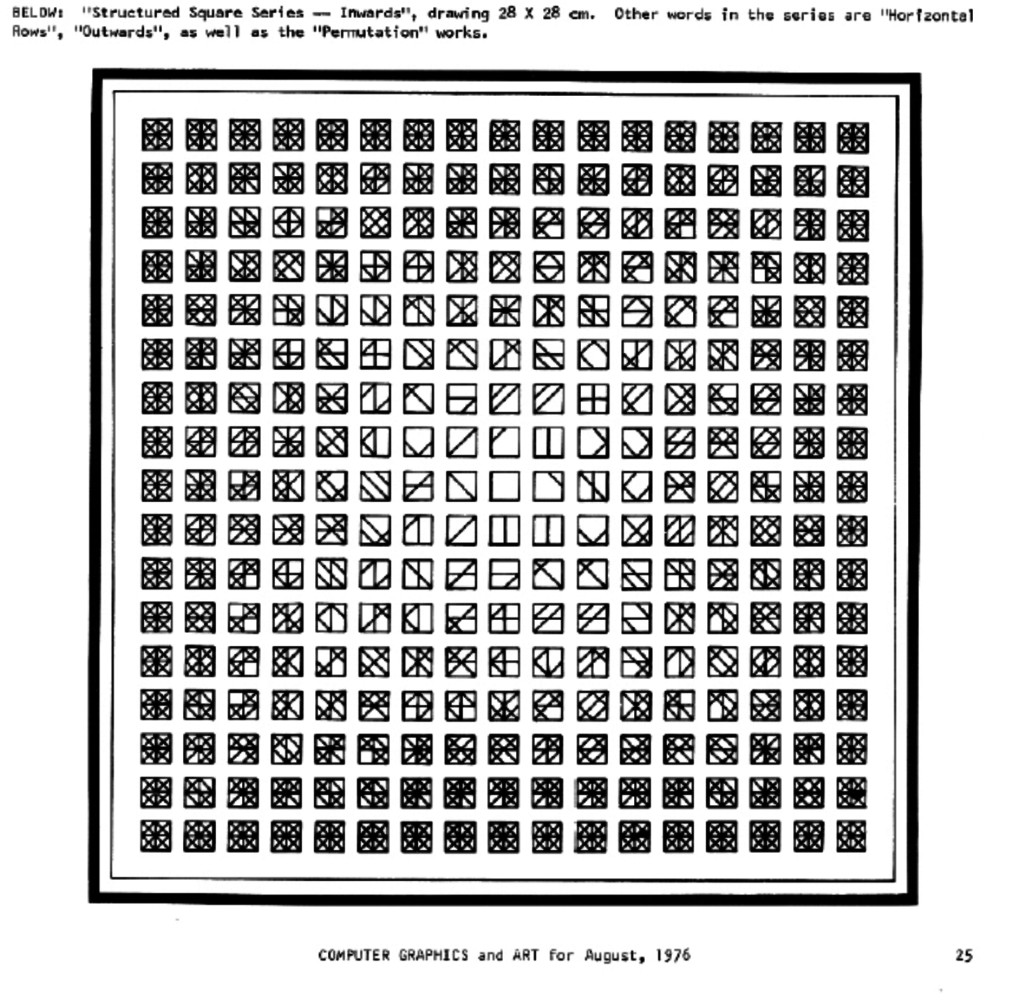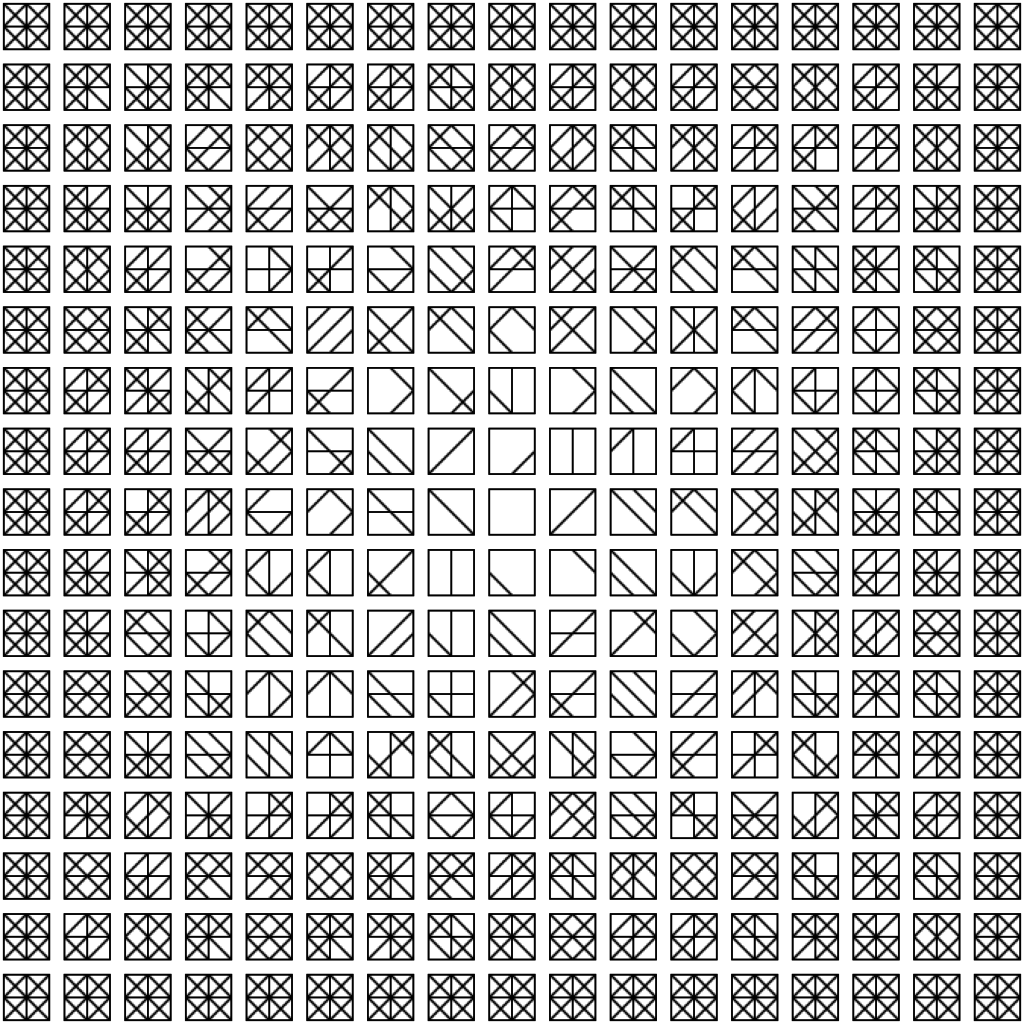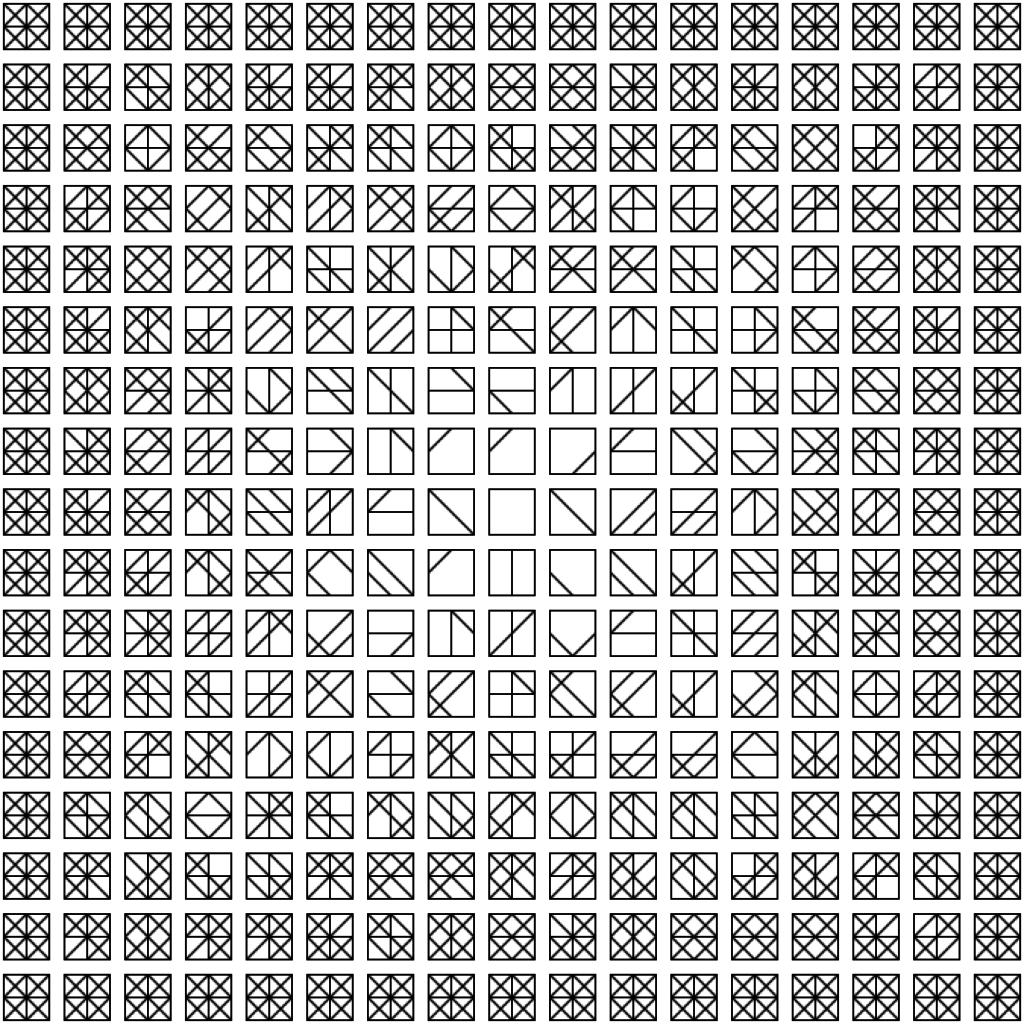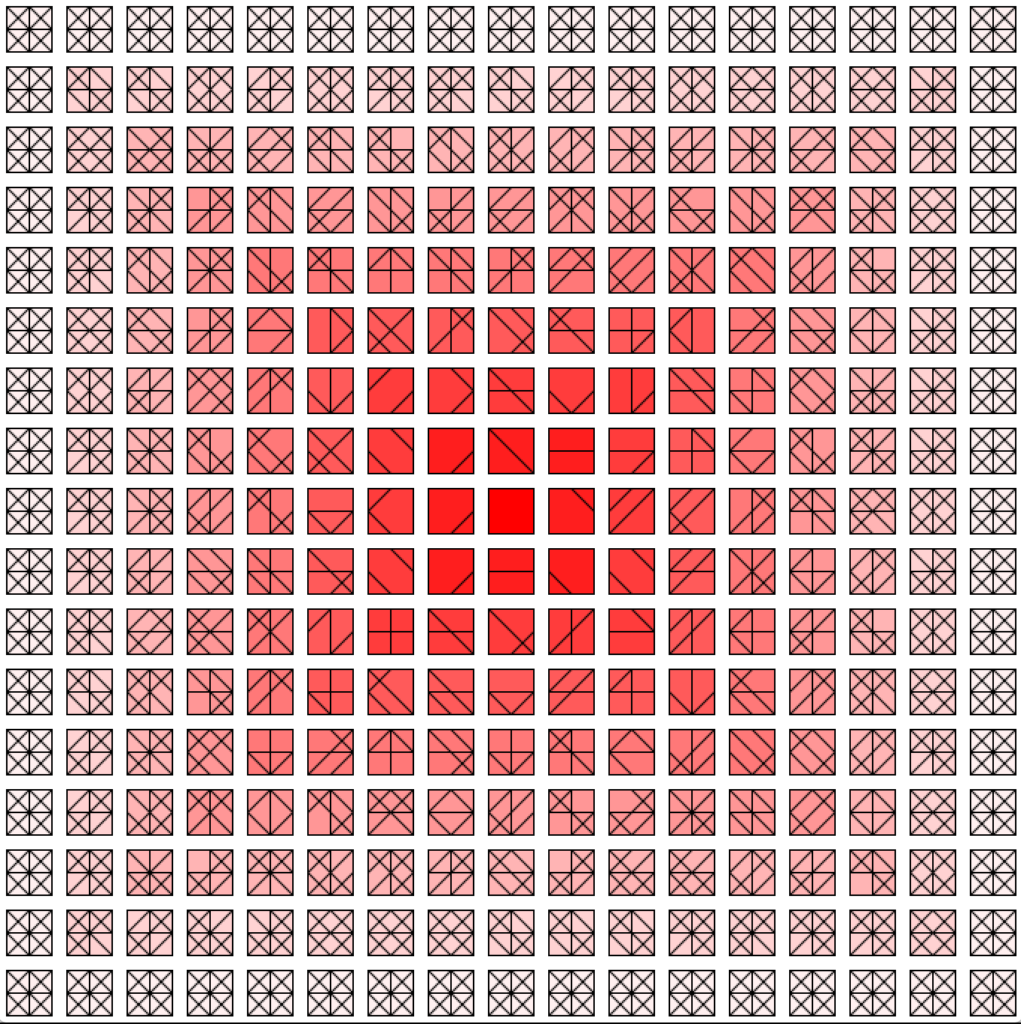For the following exercise, I have chosen to recreate “Structured Square Series — Inwards” featured in Computer Graphics and Art for August, 1976.
In the computer generated art below, the title of the piece gave me the biggest clue of how this operates as well as how the piece was designed. In the piece, the outer layer has total of 8 lines within the box (horizontal, vertical, diagonal [R-L], diagonal [L-R], and four lines triangulating the square into total of 16 equal triangles. And, as each you approach the middle of all the layers, a line is omitted – when you reach the middle, all the lines are omitted.
So, I have recreated the above artwork using processing and the results are show in the images below. For the recreation process, I have used an ArrayList and an IntList, where the arrayList contains eight arrays of quads that represent the coordinates for the triangulating lines and the IntList containing integers from 0 to 7 to represent the indexes for accessing the arrays in the arrayList.
The inner loop for k runs from k=0 to k=7 with incrementing k for every loop, and I have utilized this with a conditional check depending on the location of the squares. For instance, if the location of the square is at the third layer from the outside, it should have 6 lines drawn – and I was able to do this by adding a conditional statement that it should draw the line when k < 6. This was done for each layer to recreate the art piece correctly. Also, to create the random configuration of strokes, I have used the shuffle function of the IntList to mix the order of the stroke quads for each squares.
A version with added fill color:
<Source Code>
int w = 40;
int h = 40;
IntList indexes;
ArrayList<int[]> coords;
void setup() {
size(680, 680);
rectMode(CENTER);
coords = new ArrayList<int[]>();
indexes = new IntList();
for (int i = 0; i < 8; i++) {
indexes.append(i);
}
indexes.shuffle();
int[] coords1 = {-15, 0, 15, 0};
int[] coords2 = {-15, 0, 0, -15};
int[] coords3 = {-15, 0, 0, 15};
int[] coords4 = {-15, -15, 15, 15};
int[] coords5 = {0, -15, 0, 15};
int[] coords6 = {0, -15, 15, 0};
int[] coords7 = {0, 15, 15, 0};
int[] coords8 = {15, -15, -15, 15};
coords.add(coords1);
coords.add(coords2);
coords.add(coords3);
coords.add(coords4);
coords.add(coords5);
coords.add(coords6);
coords.add(coords7);
coords.add(coords8);
}
void draw() {
background(255);
for (int i=0; i < height; i += h) {
for (int j=0; j < width; j += w) {
pushMatrix();
translate(i+w/2, j+h/2);
for(int k = 0; k < 7; k++) {
if (i+w/2 < 40 || j+h/2 < 40 || i+w/2 > 640 || j+h/2 > 640) {
fill(255, 240, 240);
if (k == 0) {
rect(0, 0, 30, 30);
line(-15, 0, 15, 0);
line(-15, 0, 0, -15);
line(-15, 0, 0, 15);
line(-15, -15, 15, 15);
line(0, -15, 0, 15);
line(0, -15, 15, 0);
line(0, 15, 15, 0);
line(15, -15, -15, 15);
}
}
else if (i+w/2 < 80 || j+h/2 < 80 || i+w/2 > 600 || j+h/2 > 600){
fill(255, 210, 210);
if (k == 0) {
rect(0, 0, 30, 30);
}
int coordArr[] = coords.get(indexes.get(k));
line(coordArr[0], coordArr[1], coordArr[2], coordArr[3]);
}
else if (i+w/2 < 120 || j+h/2 < 120 || i+w/2 > 560 || j+h/2 > 560){
fill(255, 180, 180);
if (k == 0) {
rect(0, 0, 30, 30);
}
if (k < 6) {
int coordArr[] = coords.get(indexes.get(k));
line(coordArr[0], coordArr[1], coordArr[2], coordArr[3]);
}
}
else if (i+w/2 < 160 || j+h/2 < 160 || i+w/2 > 520 || j+h/2 > 520){
fill(255, 150, 150);
if (k == 0) {
rect(0, 0, 30, 30);
}
if (k < 5) {
int coordArr[] = coords.get(indexes.get(k));
line(coordArr[0], coordArr[1], coordArr[2], coordArr[3]);
}
}
else if (i+w/2 < 200 || j+h/2 < 200 || i+w/2 > 480 || j+h/2 > 480){
fill(255, 120, 120);
if (k == 0) {
rect(0, 0, 30, 30);
}
if (k < 4) {
int coordArr[] = coords.get(indexes.get(k));
line(coordArr[0], coordArr[1], coordArr[2], coordArr[3]);
}
}
else if (i+w/2 < 240 || j+h/2 < 240 || i+w/2 > 440 || j+h/2 > 440){
fill(255, 90, 90);
if (k == 0) {
rect(0, 0, 30, 30);
}
if (k < 3) {
int coordArr[] = coords.get(indexes.get(k));
line(coordArr[0], coordArr[1], coordArr[2], coordArr[3]);
}
}
else if (i+w/2 < 280 || j+h/2 < 280 || i+w/2 > 400 || j+h/2 > 400){
fill(255, 60, 60);
if (k == 0) {
rect(0, 0, 30, 30);
}
if (k < 2) {
int coordArr[] = coords.get(indexes.get(k));
line(coordArr[0], coordArr[1], coordArr[2], coordArr[3]);
}
}
else if (i+w/2 < 320 || j+h/2 < 320 || i+w/2 > 360 || j+h/2 > 360){
fill(255, 30, 30);
if (k == 0) {
rect(0, 0, 30, 30);
}
if (k < 1) {
int coordArr[] = coords.get(indexes.get(k));
line(coordArr[0], coordArr[1], coordArr[2], coordArr[3]);
}
}
else
{
fill(255, 0, 0);
rect(0, 0, 30, 30);
}
}
indexes.shuffle();
popMatrix();
}
}
delay(50);
}
void mousePressed() {
noLoop();
}
void mouseReleased() {
loop();
}




